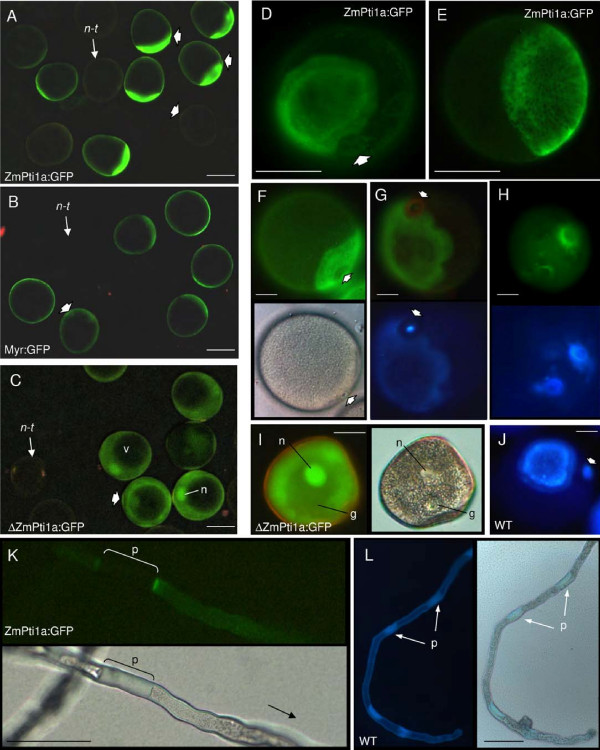Figure 6.
Expression of ZmPti1a:GFP fusions in maize pollen. Transgenic maize lines ectopically expressing wild type ZmPti1a:GFP, Myr:GFP or ΔZmPti1a:GFP (see legend Fig. 2) were generated by biolistic transformation. Immature and mature pollen of segregating plants were harvested between 8 dba and anthesis and examined by epifluorescence microscopy. non-transgenic pollen (n-t); vacuole (v); vegetative nucleus (n); generative nucleus (g), septum (s); pollen apertures are indicated by arrows. (A) ZmPti1a:GFP expression in segregating pollen 6 dba. (B) Myr:GFP expression in segregating pollen 6 dba. (C) ΔZmPti1a:GFP expression in segregating pollen 6 dba. (D-F) ZmPti1a:GFP expresed in trinucleate pollen. GFP fluorescence is visible as an annulus-ring structure adjacent to or surrounding the pollen pore. (G, H) GFP fluorescence (top) and decolorized aniline blue staining (bottom) of ZmPti1a:GFP expressing trinucleate pollen. (I) Immature binucleate pollen expressing ΔZmPti1a:GFP. GFP expression is visible in the cytoplasm and the vegetative nucleus but not in the generative cell (left); bright field image of the same pollen (right). (J) Trinucleate pollen of wild type line H99 stained with decolorized aniline blue and showing callose deposition as annulus-ring structure adjacent to the pore. (K) Tube of in vitro germinated ZmPti1a:GFP pollen on PGM showing GFP epifluorescence bordering a callose plug (p); black arrow: direction of pollen tube growth; bottom: bright field image. (L) Decolorized aniline blue staining (left) and bright field image (right) of in vitro germinated A188 pollen with callose plugs (p). Scale bars in panels A – E, K, L = 50 μm; panels F – J = 20 μm

